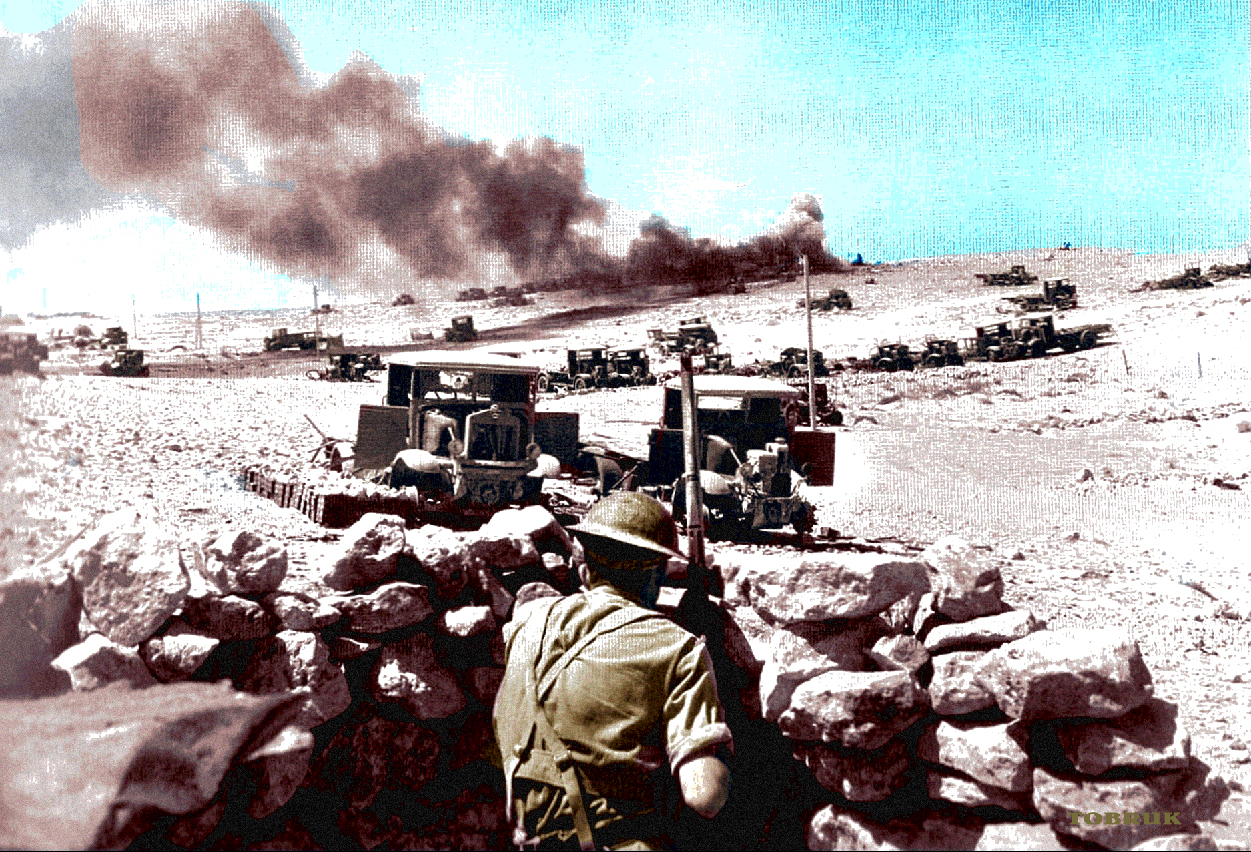Siege of Tobruk
The Siege of Tobruk is a 240-day confrontation between the troops of Great Britain and its allies and Italo – German forces during the North African campaign of World War II, the purpose of which was to control the city of Tobruk, an important port in Cyrenaica. The siege of Tobruk began on April 10-13, 1941, when the city was first attacked by the Axis troops under the command of Lieutenant General Erwin Rommel, and ended on November 27, 1941, when the British 8th Armyreleased Tobruk during Operation Crusader.
The General Course of the Battle
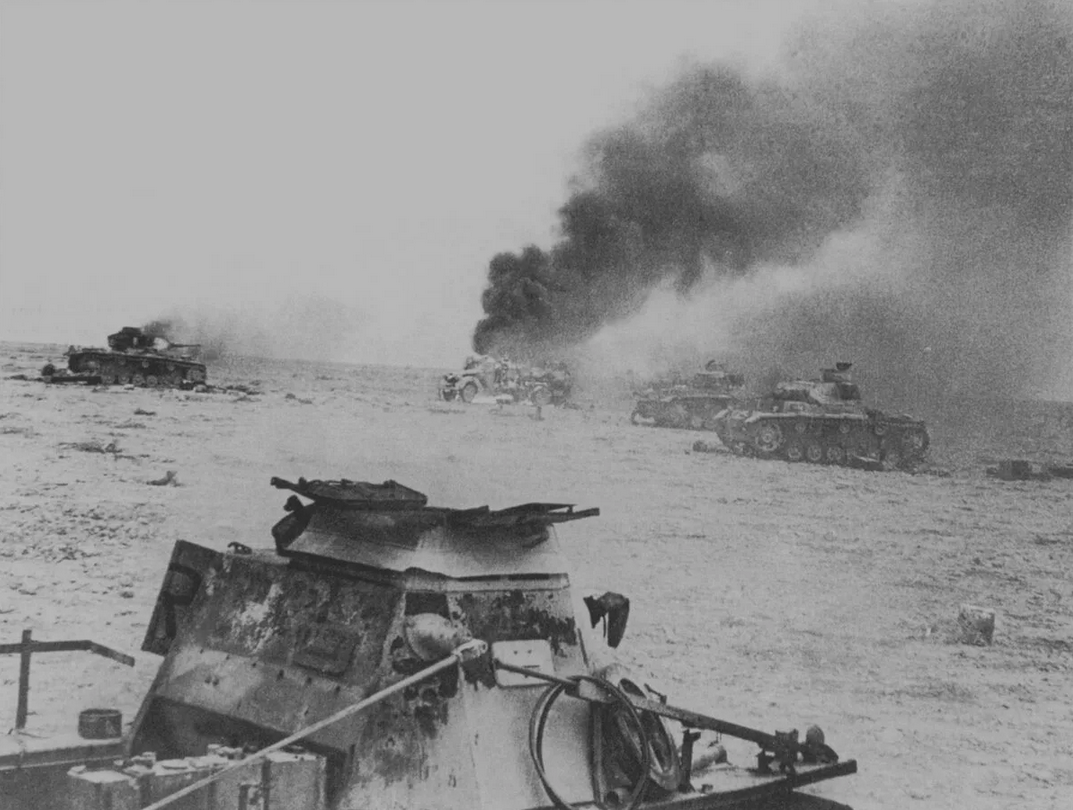
Destroyed Panzer Tanks Batlte of Toburk
For most of the siege, Tobruk was defended by Lieutenant-General Leslie Morshead ‘s Australian 9th Division. Sir Archibald Wavell, Commander-in-Chief of British Forces in the Middle East, ordered Moreshead to hold Tobruk for 8 weeks, but the Australians defended the fortress for 5 months before being replaced by the English 70th Infantry Division, the Carpathian Polish Brigade, at the request of their command, on 12 August (6000 soldiers) and the 11th Czechoslovak infantry battalion under the overall command of the British Major General Ronald Scowby. These forces defended Tobruk until the end of November, when the siege of the city was lifted by the British 8th Army, carrying out Operation Crusader.
The naval operation of the British and Australian Navy to support the supply of Tobruk played a crucial role in the defense of the city. During it, more than 34,000 soldiers, 7,000 prisoners and 7,000 wounded were evacuated from the besieged fortress. About 34,000 tons of food and ammunition were delivered to Tobruk. At the same time, the allies lost 27 ships from the actions of the fleet and aviation of the enemy.
Keeping Tobruk under his control was of decisive importance for the actions of the Allied forces in North Africa. Tobruk was the only major port from Sfax (Tunisia) to Alexandria, for about 1600 km. The capture of Tobruk by the Italo-German troops greatly simplified the supply of the latter; in addition, after the capture of this city, Rommel’s corps could freely continue the offensive across the Libyan – Egyptian border to Cairo and Alexandria, without fear of a blow from the rear from the garrison of Tobruk.
The allied defense of Tobruk played a decisive role in stopping the offensive of the armored forces of the German Africa Corps, which, during its April offensive, was able to defeat the British troops in Western Cyrenaica and capture its cities such as Derna, Zawiet Msus and Benghazi.
Although the Allied staunch defenses enabled them to hold Tobruk in 1941, the city was still occupied by the Axis on 21 June 1942 after the defeat of the Allied forces at the Battle of Gazala.
Battle of Tobruk Background
Operation Compass
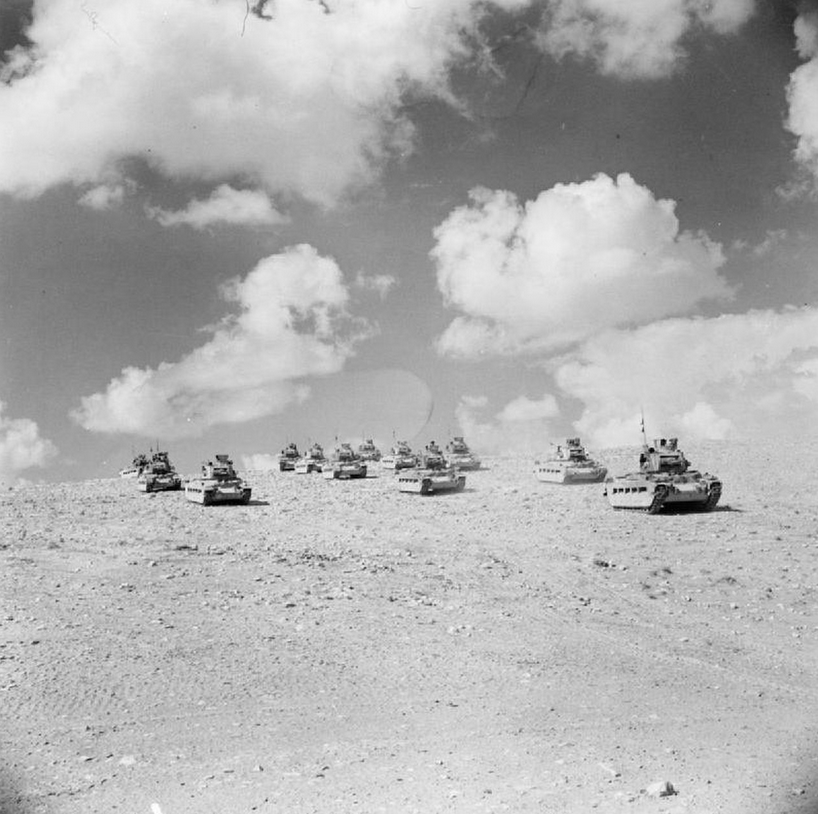
Advancing British Tanks
In January 1941, the Allies carried out Operation Compass, which had as its goal the expulsion of Italian troops from North Africa. On January 21, 1941, the Australian 6th Division attacked the Italian garrison at Tobruk, one of the few good naval bases between Tripoli and Alexandria.
The Italian forces were unable to offer effective resistance to the attackers. The nearly 30,000-strong Tobruk garrison, including the commander, General Petassi Manella, surrendered within a day of the start of the assault. The Australians, having lost 49 killed and 306 wounded, captured more than 27,000 prisoners, as well as 208 artillery pieces and 28 tanks, port equipment and vital trophies (water, fuel and ammunition). The powerful fortifications erected around Tobruk before the war did not help the Italian troops.
By February 8, 1941, Operation Compass ended with the complete success of the allies – Cyrenaica was almost completely captured (on February 7, the 6th Australian division occupied Benghazi), the 10th Italian army, which was surrounded by Beda Fomm (south of Benghazi) capitulated to the British 7th Armored Division.
However, the Allies were unable to build on their success. At a meeting of a number of military and political leaders of the Allies in Cairo (February 19-23, 1941), it was decided to send 100,000 soldiers from the most experienced units to Greece (which had been participating in the war against Italy in Epirus and Southern Albania since October 28, 1940). allied forces in Eastern Libya (for example, the most well-equipped 6th Australian division, 2nd New Zealand division from General O’Connor ‘s XIII Corpsleft North Africa) The 7th armored division, which suffered significant losses in equipment, was withdrawn to Egypt for replenishment and for some time actually ceased to exist as a combat-ready formation. XIII Corps was disbanded, and its commander led the British forces in Egypt. Henry Wilson was appointed military governor of Cyrenaica with the rank of full general, but then also went to Greece to command the British Expeditionary Force in that country.
Of the allied troops in Cyrenaica, only the 2nd British Armored Division, which had no combat experience and was technically worn out, as well as the 9th Australian Division, which had recently arrived in Egypt, remained. The British 6th Infantry Division at that time was only being formed from separate units in Egypt and did not yet have artillery and sufficient weapons. The Polish Carpathian brigade was also not fully combat-ready.
In addition, the situation of the allies in Cyrenaica was complicated by the problem of lack of supplies. The port of Benghazi could not actually be used due to the constant attacks of the Italian Air Force (which the Allies could not resist due to the transfer of most of their own fighter aircraft to Greece). The harbor of Tobruk remained the only supply hub, but in order to supply the advanced units south of Benghazi, the Allies were forced to transport military supplies for a distance of about 320 km from Tobruk.
Meanwhile, during Operation Sonnenblume (Sunflower), two divisions of the German Afrika Korps under the command of General Erwin Rommel were transported to North Africa in order to prevent the possible loss of all of Libya by the Italians. The British command ignored circumstantial evidence of the concentration of German troops in Tripolitania, since there was no intelligence evidence of this. General Archibald Wavell, commander of the allied forces in North Africa and the Middle East, apparently did not consider it possible for the enemy to attack in Cyrenaica before mid-April – early May 1941.
Rommel’s counteroffensive
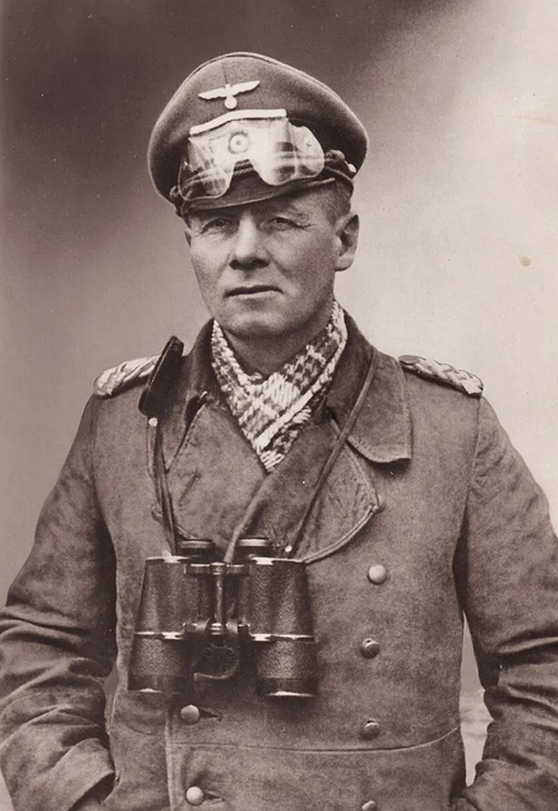
Rommel
On March 24, the Africa Corps launched an offensive deep into Cyrenaica from El Agheila. Parts of the 2nd Armored Division began to retreat, trying to direct the enemy offensive along the Mediterranean coast – to Benghazi, and at the same time block the German movement on El Mekili. However, on April 3, the division commander received a report that a significant armored force of the Afrika Korps was advancing in the direction of Zawiet Msus, where the British warehouses with fuel and military supplies were located. The 3rd Brigade of the 2nd Armored Division arrived at Zaviet-Msus and discovered that the fuel supplies there had been destroyed in advance to prevent them from being captured by the enemy. Thus, in planning its further actions, the brigade (which now amounted to only 12 cruiser tanks, 20 light and 20 captured Italian tanks as a result of combat losses and breakdowns of equipment) had to take into account an acute shortage of fuel and was ordered to retreat to El Mekili to join with 3rd Indian Motorized Brigade.
However, another unit of the 2nd Armored Division, the 2nd Support Group, was ordered to withdraw to El Regima and then to Derna.
As a result of the withdrawal of the Allied forces, the road to Benghazi and El Mekili was opened for the Axis troops, and Rommel advanced along the road along the Mediterranean coast parts of the 17th (Pavia) and 27th (Brescia) Italian divisions, at the same time ordering his motorized and mechanized units to advance deep into Cyrenaica, south of Jebel Akhdar (Green Mountains) to El Mekili after the retreat of the forces of the 3rd British tank brigade. On April 6, 1941, the forward columns of the Bersaglieri from the 132nd Italian Panzer Division “Ariete” reached El Mekili.
On April 7, the troops of Erwin Rommel took the city of Derna, surrounded shortly before, where the Germans captured 6 British generals, including Lieutenant General Richard O’Connor and Philip Neame (the new military governor of Cyrenaica). On April 8, Australian Major General John Lavarak, who had the main task of holding Tobruk, was appointed temporary commander of all allied forces in Cyrenaica, so that the command in Cairo would have time to organize the defense of Egypt.
Allied forces at El Mekili consisted by this time of the headquarters of the 2nd Armored Division (which consisted mainly of unarmored vehicles), the 3rd Indian Motorized Brigade and parts of other units, including several guns of the 1st Regiment of the Royal Cavalry artillery. Encircled, these troops initially defended El Mequili, but on April 8, the commander of the 2nd Armored Division, Major General Michael Gambier-Parry, surrendered to the Italian General Zaglio of the Pavia Division. As a result, about 2,700 British, Indians and Australians surrendered at El Mekili to Italian troops after an attempted breakthrough, reflected by parts of the Ariete division.
The original plan for Rommel’s assault on Tobruk called for tank forces to bypass the city from the south and then attack them from the east, from the side of the road to Bardia, in order to preliminarily cut off the connection between the Tobruk garrison and Cairo. However, wanting to maintain the pace of the offensive, Rommel, already approaching Tobruk, ordered the commander of the newly formed 15th Panzer Division (many units of which had not even arrived in North Africa) Major General Heinrich von Prittwitz und Gaffronselect 3 battalions from it (reconnaissance, machine-gun and anti-tank) and attack Tobruk immediately from the west, advancing along the road from Derna. Probably, Rommel did not consider the garrison of the fortress capable of defense. However, the garrison of Tobruk is the 9th Australian Infantry Division, which included the 20th and 26th Infantry Brigades (the least affected during the withdrawal from Western Cyrenaica and located in fortified positions outside the main defense perimeter of Tobruk), as well as the 20th and recently the 18th infantry brigades that arrived from Egypt (which constituted the actual garrison of the fortress) – put up stubborn resistance to the Germans.
Australian soldiers from the 2/28th Infantry Battalion were the first to notice 3 German armored vehicles approaching the city and forced them to retreat, firing with captured Italian guns. These were the first shots fired in the history of the siege of Tobruk. When Rommel’s tanks reached the bridge over the wadi in front of the fortifications of the main defensive perimeter, this crossing was blown up by the Australians. Von Prittwitz und Gaffron, who arrived at this position, ordered his driver to transport him to the other side of the wadi. The general’s car, having reached the range of fire of the Italian 47-mm anti-tank guns captured by the Australians, was destroyed by the fire of one of them. Von Prittwitz und Gaffron and his driver were killed. As a result of the ensuing 3-hour skirmish, the German forces retreated.
The Allies continued to fortify the defenses of the city, setting up barbed wire, mines and other obstacles to the actions of enemy armored vehicles. Major General Leslie Morshead, commander of the Australian 9th Infantry Division, divided the defense perimeter of Tobruk, which was about 50 kilometers long, into three sections. Each of these sectors was ordered to be defended by one brigade from the 9th division: the 26th brigade on the west side, the 20th on the south and the 24th on the east. The 18th Australian Brigade was left as a general reserve. Morshead also restored the telephone system laid down by the Italians for the center of the fortress with each of its sections. In addition, the Australians organized a system of messengers on foot in case the telephone cables were destroyed by a German attack.
Regrouping his forces, Rommel returned to his original plan for the assault on Tobruk, sending tanks on the road to Bardia. By April 11, the fortress was surrounded by troops of the 5th Light Division from the east, units of the deceased General von Prittwitz from the south, and the Brescia Division from the west.
The troops besieging Tobruk included the German Corps Africa, which consisted of the 5th Light Division and elements of the 15th Panzer Division, as well as three Italian infantry divisions and the 132nd Panzer Division Ariete. The Allied forces defending the city consisted of three brigades of the 9th Australian Infantry Division, the 18th Infantry Brigade of the 7th Australian Division (this formation was sent in advance by Wavell from Egypt to Cyrenaica), about 12,000 British soldiers (mainly artillery and supply units), the headquarters of the 3rd British armored brigade (about 60 tanks and armored cars) and 1500 Indians. In total, about 36,000 people ended up in Tobruk.people, of which about 1/3 were irregular forces, Italian prisoners of war and refugees from Western Cyrenaica. The rest of the Allied forces retreated from Libya towards the Egyptian border; general Lavarak also left Tobruk, leaving Morshead in command of the garrison of that fortress.
Easter Attacks
El Adem
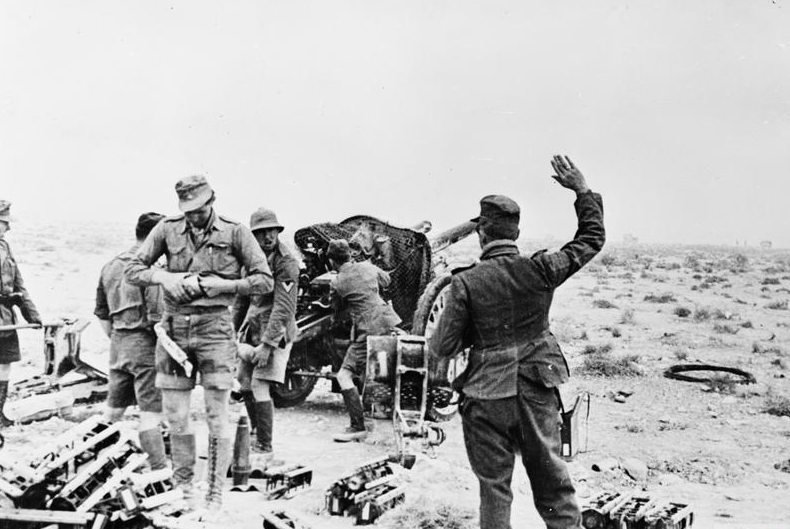
German Artillery Firing
Shortly after noon on April 11, the Italo-German forces launched a full-scale attack on the city. The 5th Armored Regiment of the 5th Light Division was the first to open fire on the defenders of the fortress, attacking the area occupied by soldiers of the 20th Australian Infantry Brigade, west of the El Adem road. During the battle, which lasted about an hour, 5 German tanks were destroyed, and the rest were forced to retreat. Around 15:00, the 2/13 Australian Infantry Battalion was attacked by a force of 400 German soldiers, who also retreated with losses to an effective barrage.
At 16:00 a platoon of 2/17 Australian infantry battalion, armed only with 2 Bren machine guns, a few dozen rifles and a few anti-tank guns, came under attack by approximately 700 German infantry, later supported by several German tanks and Italian M13 tanks, which, despite the fire Allied artillery came close to their positions, but retreated after the arrival of 4 British tanks at the battle site, which opened fire on German armored vehicles over the dug-in Australians. In this attack, the Allies lost only one man killed.
Moreshead’s plan for the defense of Tobruk was not limited to passive defense. He ordered to start patrolling the anti-tank ditches from the outside and lay more mines in front of them. While on such patrols, the 2/13th Australian Infantry Battalion found a significant amount of explosives on the outside of the fortifications. Obviously, the enemy intended to blow up the anti-tank ditch in order to facilitate the advance of his armored vehicles, but as a result of the actions of the garrison, he was forced to abandon such a plan.
In cases where German tanks or Italian tankettes reached or overcame Australian positions, the infantry took cover in bunkers well protected from tank fire, luring enemy armored vehicles into positions of the second line of defense, fortified with anti-tank guns. Thus, during one of the largest such attacks, on May 1, the armored forces of the Italo-German troops were quickly driven back from the fortifications of Tobruk, but the infantry continued to attack the Australian positions for some time before they were also forced to retreat.
On 13 April, shortly after dark, the 5th Light Division again attacked the Tobruk garrison to secure a foothold behind the anti-tank ditch west of El Adem. Despite fierce resistance from the Australian 2/17th Infantry Battalion (one of whose soldiers, Corporal John Edmondson, received the Victoria Cross posthumously for valor in this battle), the Germans managed to capture a small bridgehead, through which two armored columns of the 5th Light Division in On the night of April 14, they made a breakthrough towards the center of Tobruk and to the west in order to cut off the Allied forces defending this segment from the main garrison. However, after being under heavy fire from the 1st Royal Horse Artillery Regiment (which was soon supported by attacking the Germans from the flank, a group of dug-in British tanks”Crusader”), the Germans, having lost 16 of 38 tanks, retreated. The same failure befell the 8th German machine-gun battalion, which was advancing to the west, in support of the tanks. Attacked by significant Australian forces, as well as artillery and aircraft, the battalion lost about 3/4 of its forces that night, while the defenders of Tobruk – 90 people. As a result of this defeat, Rommel abandoned further attacks on Tobruk from the south.
Ras El Medawar
After the defeat in the battles for El Adem, Rommel decided to transfer the main vector of attack to the western sector of defense of Tobruk – the defensive perimeter around Ras El Medaouara, with the help of the Ariete Panzer Division, reinforced by the 62nd Infantry Regiment, allocated from the Italian Infantry Division “Trento”.
On April 15, 1941, an Australian combat patrol was returning from patrolling the area in the area of \u200b\u200b2/48 battalion, when a significant Italian force (about 1000 people) attacked the Australian fortifications under mortar, rifle and machine gun fire from the latter, and were able to take one of the fortified posts. The support of the defenders by the forces of the patrol that arrived at the battlefield of the 2/23rd Infantry Battalion, as well as the artillery fire of the 51st Field Artillery Regiment, decided the outcome of the battle in favor of the Allies.
Australian sorties continued on April 16, when the main forces of the 1st Battalion of the 62nd Regiment were met by the Allied forces near Akroma. The Italians came under heavy fire and then counterattacked by the 2/48th Battalion. The tanks of the Ariete division following the Italian infantry managed to break through to the main defense perimeter, but were then driven back by the fire of the 51st artillery regiment. The Australians sent machine gunners there to attack the Italian battalion from the flanks. Finally, heavy fire from three sides forced the Italian infantry to retreat, and the battle stopped. A British communiqué of 17 April 1941 described these events as follows:
One of our patrols successfully infiltrated the enemy positions outside the Tobruk defense line, capturing 7 Italian officers and 139 soldiers. Another attack on the defenders of Tobruk was repulsed by artillery fire. The enemy again suffered heavy losses. During yesterday’s operation, a total of 25 officers and 767 privates were captured. In addition, the enemy left over 200 dead on the battlefield.
One of our patrols successfully penetrated an enemy position outside the defenses of Tobruk, capturing 7 Italian officers and 139 men. A further attack on the defenses of Tobruk was repulsed by artillery fire. The enemy again suffered heavy casualties. During yesterday’s operations a total of 25 officers and 767 of other ranks were captured. In addition, over 200 enemy dead were left on the field. — New York Times
Results of hostilities in March and April
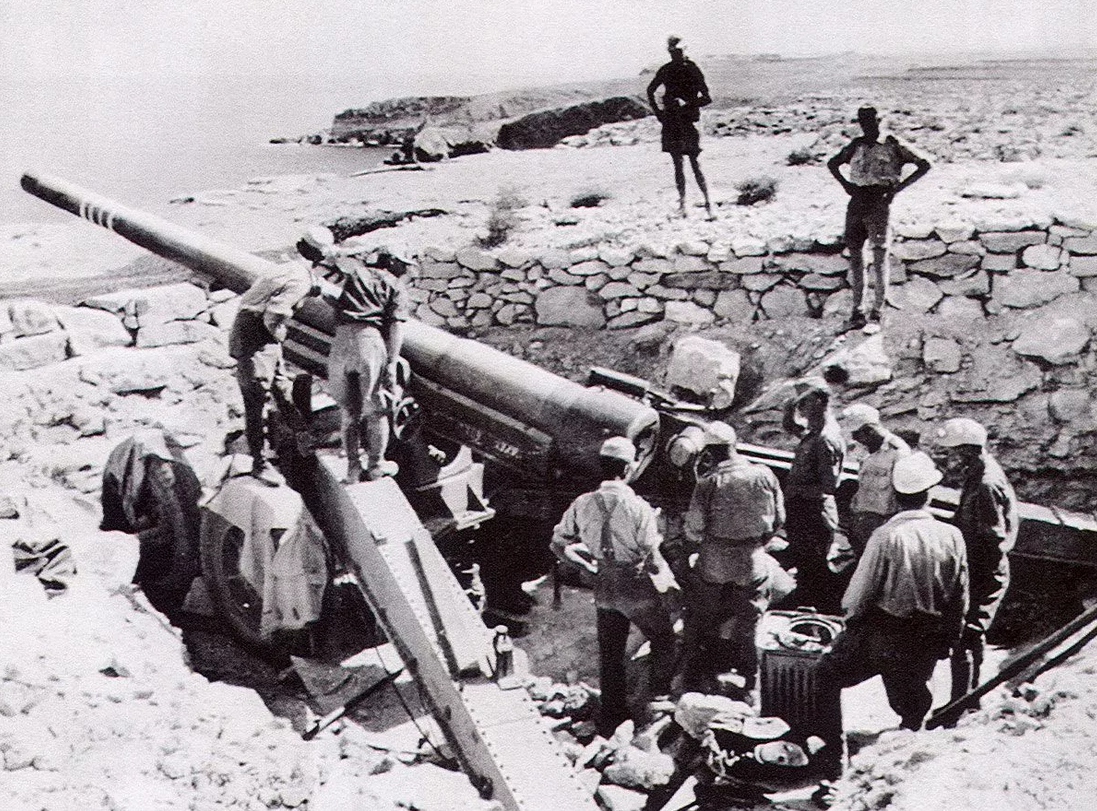
Heavy Artillery
The defenders of Tobruk were lucky that Rommel concentrated his efforts to take the fortress on such a well-defended place as Ras El Medawar was. Despite the fact that the Italians even before the war spent great efforts on the construction of the fortifications of Tobruk, he was not sufficiently protected by them from the southeast side, where the Bel Hamed and Sidi Rezegh hills dominated the area. The advancing Allies had already exploited this factor in the capture of Tobruk in January 1941, but, for some unknown reason, Rommel ignored this offensive opportunity. Probably, Rommel later took into account this mistake, when his troops in June 1942 relatively easily took Tobruk after the victory at Gazala, attacking it precisely from the southeast side.
Both sides dug into the ground, counting on a long campaign to build up strength and continue active military operations: Rommel – to capture Tobruk and resume the offensive against Egypt, Wavell – to stabilize the front on the Libyan-Egyptian border and create the prerequisites for the deblockade of Tobruk.
On May 15–16, 1941, the Allies carried out Operation Brevity, a small offensive aimed at capturing convenient positions on the border for a successful summer offensive and alleviating the situation of the Tobruk garrison. The Axis forces recaptured the city of Es-Sallum and the Halfaya Pass.
The Main Assault on Tobruk
At the end of April, at the initiative of the OKW, Lieutenant General Friedrich Paulus, Deputy Chief of the General Staff of the Wehrmacht, was sent to Libya to assess the situation at the front and obtain information about Rommel’s future plans. By that time, most of the 15th Panzer Division had already arrived in North Africa, but had not yet had time to fully restore its organization.
Rommel again chose Ras El Medaouar as the target of the attack, but now it was planned to attack it with two German tank divisions at once – the 5th light (from the southeast) and the 15th (from the southwest). After breaking through the Australian line of defense, it was planned to cut the Tobruk garrison with tank forces into two parts and hit their western grouping from the flanks with the troops of the Italian 132nd Ariete Panzer Division and the 27th Brescia Infantry Division. Paulus and Italian General Ettore Bastico (the official commander of all Axis forces in North Africa) approved the plan, which was scheduled to begin on April 30th.
On the evening of April 30, 1941, after an all-day artillery and air attack on Tobruk, the Italo-German forces attacked the left flank of the 26th Australian Infantry Brigade and penetrated the Australian defenses for about 2 miles(3.2 kilometers). At the same time, the attackers did not have the necessary interaction between individual military units to consolidate, which, moreover, suffered heavy losses from the fire of the Australians who had settled in the pillboxes and when overcoming minefields. Despite the fact that Paulus expressed doubts about the productivity of the further offensive, Rommel brought Italian units into battle, somewhat expanding the penetration front. However, tank reserves entered the battle on the part of the allies. Mutual furious, but unsuccessful attacks (German – in order to finally break through the defensive belt of Tobruk, Australian – in order to regain lost positions) continued until the night of May 4, when Rommel’s forces stopped the assault on the city.
Rommel laid the blame for the failure of the capture of Tobruk on the Italians. However, it was the Italian units (the 19th and 20th infantry regiments of the Brescia division, the 5th and 12th battalions of the Bersaglieri of the 8th regiment of the Bersaglieri, the 3rd company of the 32nd engineer battalion and the 132nd tank division “Ariete”) occupied as a result of the battle most of the positions lost by the Australians. The latter, constantly counterattacking the 7th Bersaglieri Regiment, which had strengthened on them, inflicted such losses from May to August that the regiment was withdrawn to rest and replenish in the Ain el-Ghazaly region.
The heavy losses suffered by the Italian divisions and the German 5th Light Division convinced their commanders of the impossibility of further attacks on Tobruk. Impressed by the stubborn defense of the defenders of Tobruk, Rommel, hoping for the exhaustion of the besieged and the approach of his own reinforcements, no longer attempted to storm the city until the siege was lifted from it in November 1941.
Siege and change of garrison of Tobruk
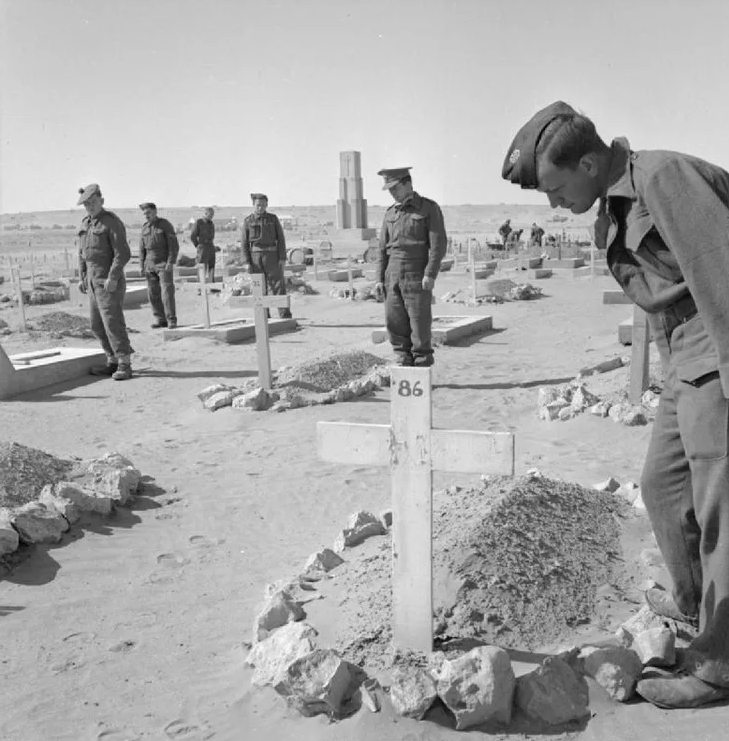
Tobruk Graves
In the summer of 1941, Australian Army Lieutenant General Thomas Blamey, with the support of the Australian Prime Minister, proposed the withdrawal of the Australian 9th Division from Tobruk in order to combine it with other Australian forces operating in North Africa (6th and 7th Infantry Divisions). General Claude Auchinleck, who replaced Wavell as commander-in-chief of the Allied forces in the Middle East, generally agreed with this opinion, but did not seek to force the development of this operation, since the movement of such a number of troops from the besieged city could only be carried out by fast warships on moonless nights (from -for the danger of enemy air strikes on ships); in addition, it distracted the allied forces from preparing for Operation Crusader.
Based on reports from the Australian High Command in the Middle East of the depletion of the Tobruk garrison, the new Australian Prime Minister, Arthur Fadden and his successor, John Curtin, rejected Churchill ‘s requests to cancel the withdrawal of the 9th Division from Tobruk, and between August and October 1941 her forces were taken out of Tobruk by the British fleet. In total, during the siege, the Australians lost about 3,000 killed and wounded; 941 soldiers were captured.
In addition to units of the 9th Division, the 18th Australian Infantry Brigade and the 18th King Edward Indian Cavalry Regiment were taken out of the fortress in August. They were replaced by the Polish Carpathian Rifle Brigade and the 11th Czechoslovak (Eastern) Infantry Battalion. The 70th British Infantry Division (which included the 32nd Tank Army Brigade), which arrived in Tobruk in September-October, finally replaced the withdrawn Australians. However, due to fleet losses incurred during the evacuation of the Tobruk garrison, the 2/13th Australian Infantry Battalion and two companies of the 2/15th Infantry Battalion, as well as separate formations of the headquarters of the 9th Infantry Division, were not withdrawn from the fortress and remained in it until the end of the siege. Leslie Morshead also left Tobruk, and the commander of the 70th Division, Major General Ronald Scowby, took over the garrison.
End of the siege
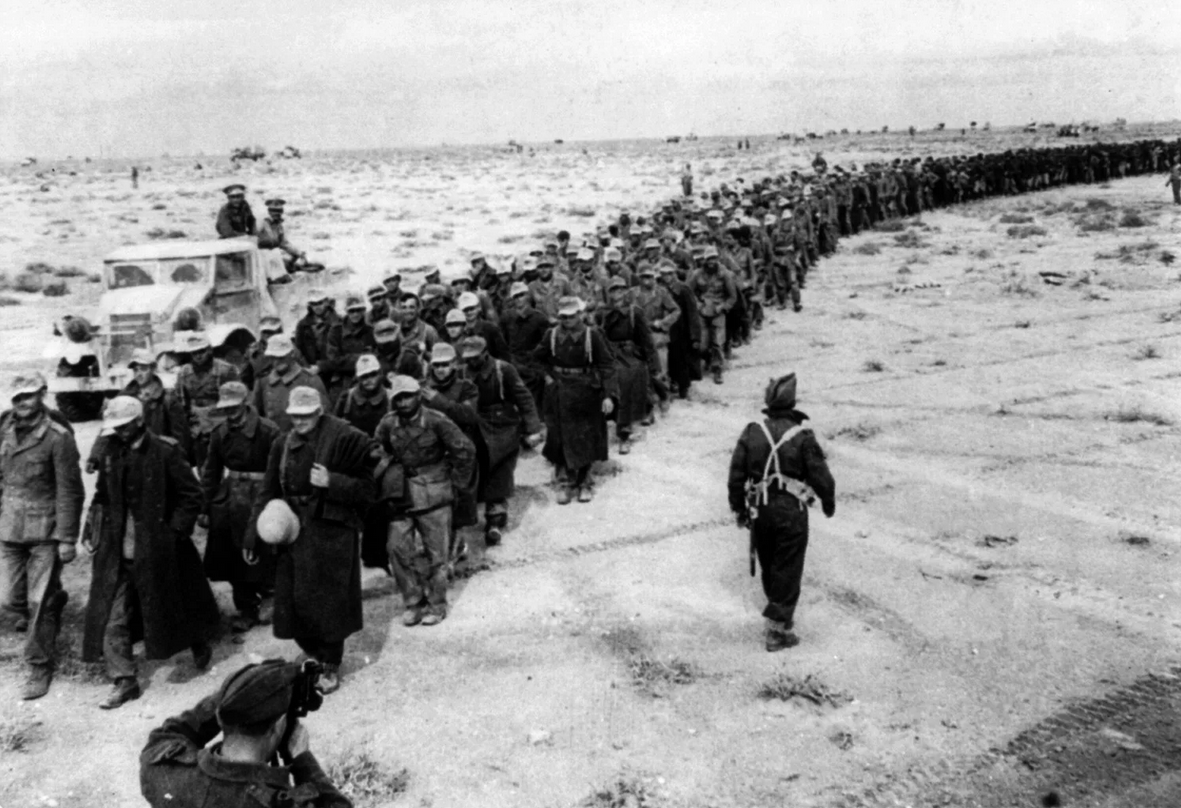
On June 15, 1941, British troops carried out Operation Battleaxe (Halberd) to break through German positions blocking the passage from Egypt to Cyrenaica and deblockade Tobruk. After crossing the Libyan border, the brigades of the British 7th Armored Division were to continue their offensive north to Tobruk, and link up with the city’s garrison there, and then advance further west as a combined force. However, the technical unreliability of the new British tanks, the inexperience of their crews, and the stubborn resistance of the Germans led to the disruption of the offensive and the loss of about 90 tanks by the Allies.
As a result of this unsuccessful offensive, General Wavell was replaced as commander-in-chief of allied forces in the Middle East by General Auchinleck. The British forces in Western Egypt were reinforced to form the two-corps Eighth Army, commanded by Lieutenant General Allan Cunningham.
As a result of heavy losses in the battle of Sidi Rezega on November 22-23, 1941, and unsuccessful attempts to reach the rear of the British, Rommel on December 7 began to withdraw his weakened troops to fortified positions at El Agheila. On 27 November the 2nd New Zealand Division linked up with the British 70th Infantry Division, thus lifting the siege of Tobruk. By the end of the year, almost all of Cyrenaica again came under the control of the allies. A significant role in this, as well as in stopping Rommel’s spring offensive in Libya, was played by the staunch defense of the defenders of Tobruk.


